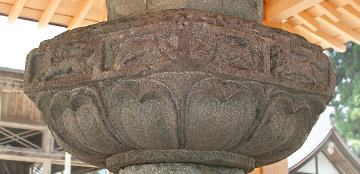|
||
 |
||
On pagodas, the ukebana consists of a single row of upturned petals, or a double row of petals with the upper row turned upwards and the lower row facing down. On the Buddhist pedestal, the ukebana takes the form of a round and relatively flat open lotus flower with six or eight upturned petals. The term is used in contrast with *kaeribana ½Τ, a similar form with petals turned downwards. @

ishidourou ΞβΔFNagataki Hakusan Jinja ·κR_Π (Gifu)
@
(C)2001 Japanese Architecture and Art Net Users System.@No reproduction or republication without written permission.
fΪΜeLXgEΚ^ECXgΘΗASΔΜRecΜ³f‘»E]ΪπΦΆά·B

